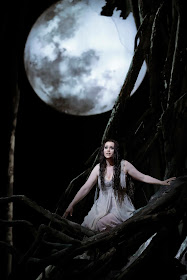Dvorak’s Rusalka
San Francisco Opera
June 21, 2019
 |
| Rachel Willis-Sorenson as Rusalka. All photos by Cory Weaver. |
One of the more unique experiences of the
opera aficionado is to fall in love with a particular aria, and then, perhaps
years later, to finally see it in its theatrical context. I have been a fan of
Dvorak’s Song to the Moon for a dozen years, owing largely to recordings by
Renee Fleming and Barbara Divis. Only now, thanks to SFO, did I get it to see
it in its proper context.
 |
| Kristinn Sigmundsson as the Water Goblin. |
This level of attachment is a perilous
thing. Boito’s “L’altra notte” is on that list, as well, and Patricia Racette
did it no favors in SFO’s Mefistofele, drowning it in emotion. I’m happy to
report that Rachel Willis-Sorenson fared much better with Song to the Moon,
helped by an intensely lush approach from Eun Sun Kim and her orchestra (Olga
Oretenberg-Rakitchenkov, harp). Willis-Sorenson possesses just the right
broadness of tone and low-to-high range to pull it off. As she sang, pleading
for a chance to become a mortal and meet her human lover, set designer John
Macfarlane’s lakeside trees shifted aside to
reveal a gorgeously oversized full moon. The completeness of the
experience was everything that I could have hoped for.
 |
| Sarah Cambidge as the foreign princess. |
Willis-Sorenson continued her inspired
vocalizing throughout the evening (except for the second act, when she was
rudely required to be mute), and also captured the audience with her acting.
Playing a water nymph completely out of sorts with her new human body, she
radiated a painful physical anxiety.
Based on folk stories and works like Undine
and Anderson’s The Little Mermaid, Kvapil’s libretto weaves these threads into
a deeply conflicted view of interspecies love. There is always, he seems to
say, a price to be paid. The intensity and suprising human-ness plays well with
Dvorak, who, late in his great career, was creating from a full and fascinating
palette. The opera incorporates turn-of-the-century features like
through-composing, the use of folk songs and Wagnerian liet-motifs. (Bits of
Song to the Moon, in fact, reappear regularly as Rusalka’s motif.)
 |
| Brandon Jovanovich as the Prince. |
The players here are exceptionally strong.
Rusalka’s father, the Water Goblin, is performed by Kristinn Sigmundsson, who
delivers a stout bass and a domineering stage presence. He is forever scaring
audience and characters alike with his surprising ascents through the stage
floor. Tenor Brandon Jovanovich is his usual excellent self, lending a
necessary charisma to the Prince. The audience has to care enough to resent his
fickleness but pity his gradual madness.
 |
| Jamie Barton as Jezibaba. |
 |
| One of Jezibaba's crows. |
Mezzo Jamie Barton brings to Jezibaba (who
grants Rusalka’s wish) a sense of cantankerous fun mixed with bits of sadism.
As the jealous foreign princess, Sarah Cambidge has just the right level of
bright sharpness (both tonally and actorly) to be amiably vicious.
Dvorak is such a masterful, inventive
musician, it’s almost no surprise that he sometimes bogs down the stage action,
but director Leah Hausman does a genius job of creating memorable stage
visions. She is helped greatly by her dancers, who perform playful wood-nymph
antics and beautiful ballets, as well as water-nymph lamentations for their lost
sister that possess the sublime eccentricity of a Martha Graham work
(choreography by Andrew George). As for Jezibaba’s crows, they nearly steal the
opera.
Macfarlane’s royal hall is stunning,
seemingly a mile long, and masterfully shadowed by David Finn’s lighting
design. Moritz Junge’s costumes are endlessly inventive.
Through June 28, War Memorial Opera House,
301 Van Ness, 415/864-3330, www.sfopera.com.
Michael J. Vaughn is the award-winning
author of The Popcorn Girl and his latest work, A Painting Called Sylvia.
 |
| John Macfarlane's royal hall. |
No comments:
Post a Comment